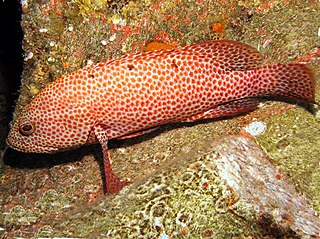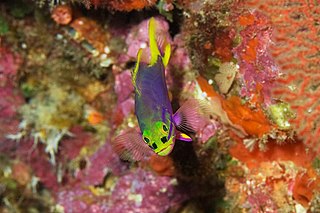
The graysby is a species of marine ray-finned fish, a grouper from the subfamily Epinephelinae which is in the family Serranidae which also includes the anthias and sea basses. It is found in the western Atlantic. It is associated with reefs and is a quarry species for commercial and recreational fisheries.

The Hong Kong grouper is a species of marine ray-finned fish, a grouper from the subfamily Epinephelinae which is part of the family Serranidae, which also includes the anthias and sea basses. It is found in eastern and southeastern Asian waters of the Western Pacific Ocean. Its natural habitats are shallow seas and coral reefs.

Epinephelus albomarginatus, the white-edged grouper, white-edged rockcod or captain fine, is a species of marine ray-finned fish, a grouper from the subfamily Epinephelinae which is part of the family Serranidae, which also includes the anthias and sea basses. It is found in the southwestern Indian Ocean and it is associated with coral reefs. It is a target species for commercial and recreational fisheries.

Epinephelus andersoni, the catface grouper, brown-spotted grouper, catface rockcod or brown spotted rockcod, is a species of marine ray-finned fish, a grouper from the subfamily Epinephelinae which is part of the family Serranidae, which also includes the anthias and sea basses. It is found in the southwestern Indian Ocean where it is associated with reefs.

The potato grouper, also called the potato cod or potato bass, is a species of marine ray-finned fish, a grouper from the subfamily Epinephelinae which is part of the family Serranidae, which also includes the anthias and sea basses. It has a wide Indo-Pacific distribution.

Cephalopholis miniata, also known as the coral grouper, coral hind, coral rock cod, coral cod, coral trout, round-tailed trout or vermillion seabass is a species of marine ray-finned fish, a grouper from the subfamily Epinephelinae which is in the family Serranidae which also includes the anthias and sea basses. It is associated with coral reefs and occurs in the Indo-Pacific.

Cephalopholis taeniops, the African hind, bluespotted sea bass or spotted grouper, is a species of marine ray-finned fish, a grouper from the subfamily Epinephelinae which is in the family Serranidae which also includes the anthias and sea basses. This species occasionally makes its way into the aquarium trade and is a target for local fisheries. It is found in the eastern Atlantic Ocean.

Cephalopholis formosa, the Bluelined hind or bluelined rockcod is a species of marine ray-finned fish, a grouper from the subfamily Epinephelinae which is in the family Serranidae which also includes the anthias and sea basses. It is found in the Indo-Pacific where it is associated with reefs. It is sometimes found in the aquarium trade.

Cephalopholis fulva, the coney or the butterfish, is a species of marine ray-finned fish, a grouper from the subfamily Epinephelinae which is in the family Serranidae which also includes the anthias and sea basses. It is found in the western Atlantic. It is associated with reefs and is a quarry species for commercial and recreational fisheries. It can be found in the aquarium trade.

Cephalopholis panamensis, the Pacific graysby or Panama graysby, is a species of marine ray-finned fish, a grouper from the subfamily Epinephelinae which is in the family Serranidae which also includes the anthias and sea basses. It is found in the Eastern Pacific Ocean.

Cephalopholis polleni, the harlequin hind, harlequin grouper, harlequin cod, harlequin rockcod or blue-lined grouper, is a species of marine ray-finned fish, a grouper from the subfamily Epinephelinae which is in the family Serranidae which also includes the anthias and sea basses. This fish occurs around offshore islands in the Indo-Pacific region. It occasionally makes its way into the aquarium trade.

Cephalopholis urodeta, the darkfin hind, flagtail rockcod, chevron rockcod, duskyfin hind, duskyfin rockcod, flagtail grouper or V-tail grouper, is a species of marine ray-finned fish, a grouper from the subfamily Epinephelinae which is in the family Serranidae which also includes the anthias and sea basses. This fish occurs in the Western Pacific Ocean and the far eastern Indian Ocean.

Cephalopholis spiloparaea, known commonly as the strawberry hindstrawberry rock cod, strawberry cod or orange rock cod, is a species of marine ray-finned fish, a grouper from the subfamily Epinephelinae which is in the family Serranidae which also includes the anthias and sea basses. This fish occurs throughout the Indo-Pacific region.

The longfin grouper, also known as the longfin rockcod, bar-breasted rock-cod, Gilbert's rock-cod, honeycomb rockcod, spotted groper or wirenet cod, is a species of marine ray-finned fish, a grouper from the subfamily Epinephelinae which is part of the family Serranidae, which also includes the anthias and sea basses. It is found in the Western Pacific Ocean.

Cephalopholis sexmaculata, sixblotch hind, freckled cod, freckled rock-cod, sixband cod, six-banded rockcod, sixband rockcod or sixspot rockcod is a species of marine ray-finned fish, a grouper from the subfamily Epinephelinae which is in the family Serranidae which also includes the anthias and sea basses. This fish occurs throughout the Indo-Pacific region.

Cephalopholis nigripinnis, the blackfin grouper, banded-tail coral-cod, blackfin rockcod, darkfin hind or duskyfin rockcod, is a species of marine ray-finned fish, a grouper from the subfamily Epinephelinae which is in the family Serranidae which also includes the anthias and sea basses. It is found in the tropical Indian Ocean.

Epinephelus undulosus, the wavy-lined grouper, brown-lined reefcod, mid-water rockcod, mid-water grouper, is a species of marine ray-finned fish, a grouper from the subfamily Epinephelinae which is part of the family Serranidae, which also includes the anthias and sea basses. It has a wide Indo-Pacific distribution. They are produced through aquaculture and commercially fished.

The masked grouper, also known as the thinspine grouper, rededged cod, red-edged grouper, slenderspine grouper, thinspine rockcod, white-margined grouper, white-square cod or white-square grouper, is a species of marine ray-finned fish, a grouper from the subfamily Epinephelinae which is part of the family Serranidae, which also includes the anthias and sea basses. It is found in the western Atlantic Ocean. It is the only species in the genus Gracila.

Cephalopholis igarashiensis, known as the garish hind, Neptune grouper, goldbar grouper, or Japanese cod, is a deepwater species of marine ray-finned fish, a grouper from the subfamily Epinephelinae which is in the family Serranidae which also includes the anthias and sea basses. It is found on coral reefs at depths of 80 to 250 m in the Indo-Pacific.

Cephalopholis sonnerati, known as the tomato hind, tomato rockcod, or tomato cod, is a species of marine ray-finned fish, a grouper from the subfamily Epinephelinae which is in the family Serranidae which also includes the anthias and sea basses. It is distributed on coral reefs in the tropical Indo-Pacific. It is also sometimes called the orange-spotted cod, red coral cod, red rockcod, tomato grouper, or tomato seabass.





















